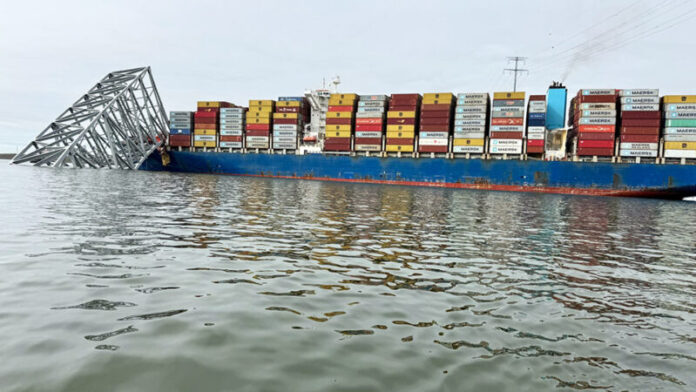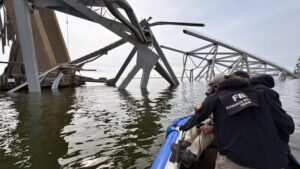
-
Ships are unable to enter or exit the Port of Baltimore after the Francis Scott Key Bridge collapsed March 26
-
Supply chain has been strained and delivery schedules disrupted
-
Container ship Dali had collided with one of the bridge’s supports causing it to collapse
The flow of ships in and out of the Port of Baltimore has been halted by the Francis Scott Key Bridge collapse on March 26.
As a result, the local economy – specifically along the East Coast – could be hampered, with the supply chain strained and delivery schedules disrupted.
The bridge collapsed after container vessel Dali, operated by Singapore-based Synergy Group, collided with one of its supports. At the time of the accident, the Dali had been chartered by the shipping giant Maersk.
Six are presumed dead, with the US Coast Guard calling off search for the missing construction workers who were filling potholes on the bridge at the time of the tragedy.

Ship traffic to and from the Port of Baltimore was suspended indefinitely, requiring rerouting of vessels or cargo to other ports, potentially causing congestion and delays for importers.
While traffic was suspended indefinitely, trucks were still being processed at the port’s terminals.
Maersk said they were omitting Baltimore on all its services for the meantime, at least “until it is deemed safe for passage through this area.” The carrier, however, warned customers that delays were likely.
Nationwide Financial markets economist Oren Klachkin said, the bridge’s collapse “threatens to disrupt logistics activity up and down the East Coast.”
This is because traffic logjams are likely to occur on the Interstate 95 corridor, a major traffic artery along the East Coast.
Baltimore is closer to the Midwest than any other East Coast port and Baltimore is a major hub for vehicles, containers, and commodities. Baltimore ranks first among US ports for cars and light trucks. It handled a record 850,000 motor vehicles last year.
In a statement, carmaker VW said they shipped some 100,000 vehicles along Baltimore for US dealer in the Northeast and Mid-Atlantic.
“We do not anticipate any impact on vessel operations but there may be trucking delays as traffic will be rerouted in the area,” the company said.
Seven container ships were scheduled to arrive at the port over the weekend.
Jessica Gail, spokesperson for the American Trucking Associations, said the accident has “significant and long-lasting impacts on the region.” About 1.3 million trucks cross the bridge every year or 3,600 a day, she said.
According to Gail, trucks that carry dangerous goods will now have to make 30 miles of detours around Baltimore because they are prohibited from using the city’s tunnels, adding to delays and increasing fuel costs.
US President Joe Biden said the federal government would help get the port reopened as soon as possible, but gave no timeframe on when this would happen.
Said Biden: “Fifteen thousand jobs depend on that port, and we’re going to do everything we can to protect those jobs and help those workers.”
While there may be increased cost of shipping as a result of the bridge’s closure, the disruptions are not likely to cause problems for the US economy as a whole, according to Mark Zandi, chief economist for Moody’s Analytics. Goods are likely to find other ports, he explained.
“This specific event should not show up in the national economics statistics,” said Zandi, “It complicates things, but there’s already a lot of disruptions in the international supply chain.”
Maryland Gov. Wes Moore said at the start of this week that it was still too early to say when ships will begin calling on the port again.




